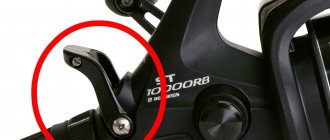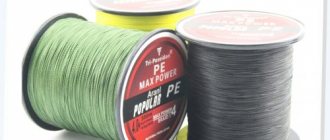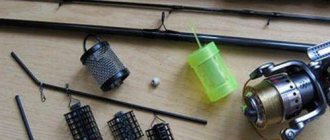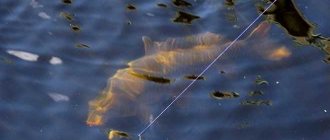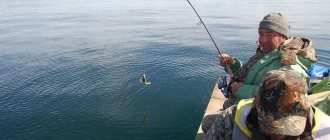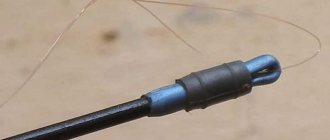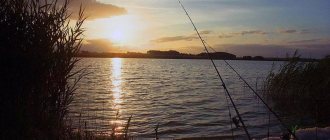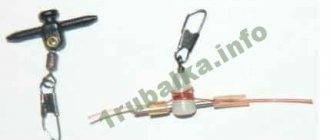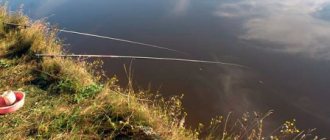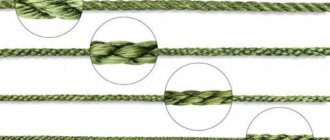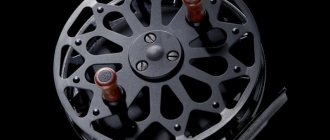Selection of baits and baits
To catch predators using float tackle, live bait is used: bloodworms and maggots in winter, worms and maggots in summer.
Tips and baits for fishing in warm and cold water
Peaceful fish species are caught on:
- crumb;
- dough;
- barley;
- corn with added flavorings such as anise or hemp oil.
But they also go after a worm with maggots with pleasure, especially in spring and autumn, when protein baits work best:
- worm;
- maggot;
- bloodworm;
- caddisfly;
- shitik;
- dung beetle and others.
It is advisable to have several types of bait with you, since the taste of fish changes depending on the weather, as well as the place and time of fishing.
What should you pay attention to when choosing?
When you decide to purchase a fishing line for a float fishing rod, you should consider several points in order to choose the right fishing line for fishing, including:
- color;
- length;
- diameter;
- density.
To avoid additional difficulties in the selection process, let’s consider each of these parameters in more detail and figure out what is worth paying especially close attention to
Color
In most cases, the color of the fishing line plays an insignificant role. However, it should be noted that its color should not be particularly bright, because the fishing line can scare away the fish and you will return home without a catch.
When choosing the color of the fishing line, you should also take into account the fishing location and the degree of water transparency.
Therefore, please pay attention to the following rules:
- If the water is cloudy, you can give preference to the brown option.
- If you intend to fish in clear water, then you should take a line that is already transparent, because the fish will notice any other color in the water.
- When fishing at night, many people prefer blue, black and dark brown fishing lines.
- If you plan to fish in grassy areas, then the best option is a green fishing line.
Recently, “dotted” fishing lines have become popular, i.e. multi-colored, on which dark and light tones alternate. Such fishing lines are usually invisible against the background of vegetation and the bottom.
How to catch more fish?
- More sensitive gear. Reviews and instructions for other types of gear can be found on the pages of my website.
- Lures using pheromones.
You can get the rest of the secrets of successful fishing for free by reading our other articles on the site.
Length
The length of the fishing line largely depends on the weight of the fish, as well as the design of the rod. However, it is worth noting that most anglers prefer a line length for a float rod equal to 9/10 of the length of the rod. Why? Everything is quite simple: this length allows you to easily attach the bait, as well as pick up already caught fish with your hand.
Diameter
What fishing line diameter should I choose? Most new fishermen face this question. In fact, there is nothing complicated here: the larger the diameter, the stronger the line, but the more noticeable it is to the fish.
It is also worth noting that as the diameter increases, the fishing line becomes coarser and stiffer.
It is also important to say that if the line is too stiff, the weight of the sinker may not be enough to tension it well, and this also causes discomfort, because first you will have to straighten the line, and only then the float will show you when the fish is biting. As a standard, experts indicate the following diameter for the float line from 0.08 mm to 0.25 mm
But it’s worth noting that 0.08 mm is suitable for sport fishermen, and 0.25 mm is a bit rough, so the optimal solution is a line with a diameter of 0.1-0.2 mm, which is perfect for fishing with a float rod
As a standard, experts indicate the following diameter for the float line from 0.08 mm to 0.25 mm. But it’s worth noting that 0.08 mm is suitable for sport fishermen, and 0.25 mm is a bit rough, so the optimal solution is a line with a diameter of 0.1-0.2 mm, which is perfect for fishing with a float rod.
If you plan to catch a specific type of fish, then you can choose the diameter depending on this, so, for example, a size of 0.15 mm is suitable for perch, and 0.3 mm for carp, etc.
Density
All types of fishing line can be divided into 2 types:
- floating;
- drowning
As you might have guessed, the properties of a fishing line are determined by its name; a floating line floats on water, a sinking line sinks. This happens because the floating version has a lower density than the sinking one.
For float fishing rods, the most suitable is a floating line, because... thanks to it it is much more convenient to control the equipment. Many fishermen, in order to reduce the density of the fishing line, lubricate it with special fat so that it does not sink.
They also prefer to use a line whose specific gravity is heavier than water. Why? Everything is quite simple - such a fishing line and float are not affected by the wind, because it is completely immersed in water. There is also a small minus here; if the line is too heavy, it can begin to pull the float along with it and create an arc under water, which can increase the hooking time.
In conclusion, it is worth noting that after reading this article, you can easily choose a fishing line for your float rod yourself, as well as help your friends with the choice.
https://youtube.com/watch?v=gVD4eGcUxvU
Choice depending on the type of fish
The most important criterion when choosing a fishing line is, of course, the fish for which the tackle is being prepared.
Line thickness when fishing for crucian carp
The following diameters are perfect for small crucian carp (depending on the size of the crucian carp you come across and the possibility of “hooking” a larger fish, carp, for example, where the smallest value means there are no options to hook a large fish, and the highest value means there is a high probability of picking up a large specimen):
- monofilament – from 0.13 to 0.18 mm;
- fluorocarbon – from 0.14 to 0.2 mm;
- braid - from 0.09 mm.
Carp
The diameter of the fishing line, as well as its type, depend on which carp most often “cling” to your pond. Speaking of 1.5–2 kilograms, it is better to use:
- Monofilament not lower than 0.18 and up to 0.28 mm;
- Fluorocarbon – at least 0.04 mm wider than monofilament;
- Braid - only for long casts with a leash. Used to reduce stretch (elasticity) when hooking.
Small fish (bream, roach, rudd, goby)
There is no need to spend money on fluorocarbon to equip a float rod for catching roach. Ordinary monofilament fishing line is also perfect, and the narrower it is, the better.
In the case of a float rod, the leash plays a big role. The thinner it is, the less traceable the bait/tackle path will be for the fish, which means the more likely a bite will become. But don't make it too thin. The difference between the strength characteristics should not be more than 300g.
Types of float rods
Float rods are divided into 4 types, each with its own specifics:
Flying rods
The most accessible and easiest way of fishing. This is the kind of rod a beginner should choose
. Suitable for all reservoirs without current or with weak current, where long casting is not required. Allows you to prepare equipment on reels in advance and quickly change them if necessary.
It should be taken into account that when fishing with a fly rod, difficulties may arise when landing large fish. The main load falls on the fishing line and blank, so such rods should be chosen for the possibility of catching fish up to about 2 kg. It should be remembered that a lot depends on the skills of the fisherman.
Bolognese rods
Classic Bolognese fishing is fishing in the current with a 5-8 m rod.
But in the Krasnodar Territory, shorter versions of rods of 4-5 m with rings and a reel are mainly used. This is a very common fishing method.
A wide range of Bolognese fishing rods in length allows you to choose the best option for different conditions. You can fish both on large rivers with currents and on small bodies of water with standing water. A precisely tuned clutch allows you to catch large specimens. Bolognese fishing rods are most often telescopic. This allows you to disassemble and assemble the tackle quite quickly. The lap dogs are also convenient for transportation.
It should be remembered that Bolognese fishing rods, made of high-modulus carbon, require careful handling. You especially need to be careful when assembling and disassembling the fishing rod.
If an angler has chosen an active fishing method with a rod of 7 meters or more, then it is most convenient to use the lightest possible carbon rod. Such fishing rods have a high cost, along with high performance characteristics.
Match rods
Plug rods 3.6-4.5 m long with a large number of guide rings are used. Used in cases where long casting
50-70 m. If you choose the right place, feed it well and fine-tune the equipment, then this method will be effective and will not be inferior to other methods of float fishing.
Plug rods
It is a long float rod. Can reach up to 15 meters or more.
Suitable for catching small white fish, as well as for catching carp. This tackle allows you to quickly change the upper knees. The fisherman does not waste time adapting to different conditions.
This method of fishing requires a certain free space behind the angler’s back and additional auxiliary equipment.
This type of rod is often chosen by experienced fishermen for sporting competitions. The cost of such rods can reach tens of thousands of rubles.
The photo shows classic pictures of float fishing
Typical examples of classic plug-in float rods: Sabaneev plug-in rod Master 1300 (n), Sabaneev Tenzor rod 1300 13.0m.
We've sorted out the types, now let's move on to studying the characteristics of float rods.
Monofilament fishing line
This is the most common fishing line that our fathers and grandfathers used to fish. It has many pros and cons, which is why it is used quite often by anglers.
The advantages of monks include:
- Availability, since the price for it is on average low, of course there are expensive fishing lines with inflated characteristics, but still, most fishermen can afford monk.
- Good stretchability, due to which, with a sharp and strong jerk, it does not tear immediately, but first stretches, absorbing the jerks of the fish. There is also a downside to the coin: the fishing line loses sensitivity.
- It has a low coefficient of friction, thanks to which it flies quite far.
- Frost resistance, withstands frost much better than wicker.
- Unnoticeable in water.
- In most cases, the indicated diameter on the packaging corresponds to the actual diameter.
The disadvantages include
When spinning fishing with a jig, as well as a feeder with a fishing range of over 35 m, the stretchability of the monk becomes its disadvantage, since it does not provide such sensitivity as braided line. It is highly susceptible to exposure to the sun, water, and temperature changes due to which, under their influence, it loses its strength and elasticity (this process is also called fishing line aging). Also, when the fishing line dries out, it gradually deforms itself on the reel, and its internal turns become ribbed and less durable.
Therefore, it is recommended to change the fishing line every fishing season. Loses strength at bend points, especially at knots. When choosing a monofilament fishing line, you should pay attention to the label; if it is glued unevenly, then most likely it is a fake. Also, the fishing line should have a glossy finish, which means that it is new and has not yet had time to sit, but if it has a dull matte finish, it means that it has been lying around for a long time and has lost some of its qualities. Due to the fact that we use a monofilament of a larger diameter than a braided one, our casting range will decrease.
You also need to take into account such a concept as “line memory” (residual deformation after loads), the smaller it is, the better. In order to determine the “memory” of the fishing line, it must be pulled, with a confident tension, between two clamped fingers, after which it should remain even and smooth, this means that the fishing line is not old, well calibrated and has almost no memory. The only case when line memory plays a minimal role is when fishing with a fly rod without a reel; in this case, the line is attached to the tip of the rod, and after fishing it is wound on the reel.
The most demanding fishermen can also take with them a special micrometer device and measure its size in different areas. A good fishing line should have the same diameter along its entire length.
Fishing lines from the following manufacturers are in demand among anglers: Allvega, Kosadaka, SUFIX, Owner Shimano, Colmic, Maver, Balsax, Daiwa, Sunline. If you fish in places where the bottom is covered with shellfish, then you should choose a fishing line that is made using multi-layer coating technology, where a rather soft middle is enclosed in a durable shell.
Monoline is used in float fishing, when fishing on a feeder (at a distance of up to 30 m, especially if you are hunting for large fish) and spinning as the main and leader line, although when catching large predators, especially catfish and pike, it is not recommended to use monofilament fishing rods.
Choosing fishing line depending on the material
Before the advent of synthetic materials, fishing lines were made from silk, flax, horsehair was used, it is the most durable of materials, fishing lines were made by hand, covered with impregnations that isolated water, and closer to the 90s, industrial knitting machines for making fishing lines appeared. Modern materials and types of manufacturing have changed; fishing lines are made from synthetic nylon fibers, nylon, polyethylene, and fluorocarbon.
1. Nylon fishing line was the very first artificial fiber fishing line, invented in the USA, and has a low refractive index of light compared to other materials.
2. Nylon fishing lines were first produced in Germany; they wear out very quickly and will not last more than 2 years.
3. Lines made of polyethylene or monofilament, low tensile, high strength, first produced in Holland. The fishing lines are equipped with protective hydro impregnation and have special weaving features. Fishermen have not identified any shortcomings of polyethylene fishing line; it is strong and thin.
4. Fluorocarbon fishing line did not appear on the fishing tackle market right away, as it was invented for oil workers. Fluorocarbon is highly resistant to different temperatures, the fishing line does not deteriorate under ultraviolet rays, and does not change under the influence of aggressive chemical materials. A line made of this material quickly sinks in the water, since fluorocarbon is heavier than all other materials, which is an advantage for float fishing. In terms of physical properties, the fishing line is very rigid, it is difficult to tear, and is not noticeable in water. Fluorocarbon line is used for fishing with feeder rods, float rods, spinning rods, and this line is also good for shock leaders.
Monofilament fishing lines coated with fluorocarbon are the most popular among anglers. Suitable for perfect fishing.
Monofilament fishing line is perfect for feeder rods; fluorocarbon is suitable for leashes. In jig fishing, braided fishing line is used. Monofilament fishing line performed well in float fishing. In winter, for any type of fishing, it is better to choose a fluorocarbon line.
Expert's comments
Nikita Dupin (ndup), sports fisherman, representative of the FishingSib float fishing team, organizer of sporting events on fishing topics:
— There are a lot of places in Novosibirsk where catching crucian carp in the spring is a pleasure. Starting from lakes and water meadows, ending with Ob channels and flooded bushes. As for my favorite place, I’m not averse to catching crucian carp in the summer within the city - this is the pit on the Gorsky railway station. Within the city limits, according to my observations, crucian carp bite best on a worm; sometimes I use semolina and Chinese dough as bait, especially on lakes. Don’t forget about bloodworms; it’s especially good to catch them in reservoirs where there are no roaches and other small fish that love them very much.
Dear lovers of float fishing, who are just getting acquainted with this issue - we hope that this selection of facts and tips has helped you and the summer fishing season will bring you trophy crucian carp.
Want to know more about float fishing? Welcome to the official forum topic>>>
Rating of the 11 best fishing lines for a float fishing rod
Colmic Power – practically without memory, which is suitable for fishing with a Bolognese fishing rod. One of the best and most popular fishing lines for float fishing. Price 480 rubles.
Colmic Fendreel and Colmic X-5000 – I again give the second position to the Japanese manufacturer, since this line is ideal for fishing with a fly rod. Price from 600 to 700 rubles. But it makes sense to pay.
First top 6 models
Maver Dual Band – suitable for float and match fishing. Use on both Bolognese and fly rods. This is a sinking line without memory effect. Price from 650 rubles and above. Depending on the unwinding.
Trabucco T-Force XPS Match Extra Strong is an Italian high-quality monofilament that is suitable for float fishing as a base and leaders. Produced in unwinding lengths of 25, 50 and 100 meters. Price from 180 rubles for 25 meters.
Shimano Technium is a strong and reliable monofilament from a well-known manufacturer of fishing products. Invisible in water and has low elongation. I don’t recommend taking it for beginners because of the price from 1150 rubles for 150 meters.
Yamamoto - soft monofilament will not scare off even the most picky crucian carp. Excellent abrasion resistance and minimal mechanical memory. Large selection of diameters. Price 730 rubles per 100 meters.
Owner Broad - high-quality fishing line is better suited for fishing with Bolognese tackle. Low stretch is not as good for swing fishing. Not suitable for matcha either. In demand due to the ratio of price and quality. Unwinding 100 meters costs 350 rubles.
Balsax Iguana is a sinking fishing line with good elongation and knot strength. Suitable for beginners as a budget option, since its price is only 180 rubles per 100 meters. The main thing is not to fall for a fake, of which there are many. Therefore, it is advisable to buy from a trusted store.
Final 5 Best Options
Sabaneev Tenzor – fairly accurate calibration along the entire length of the monofilament. The price-quality ratio is excellent. This is a godsend for float fishing enthusiasts who do not want to buy expensive brands. A soft thread with a smooth surface is successfully used for bologna and fly tackle. Sold in unwinding lengths of 50 and 100 meters with a price starting from 100 rubles. Expensive options are a little better quality, but also more expensive.
Dunaev General All Round – has neutral buoyancy and medium stiffness. It is popular among fishermen due to its quality and price from 180 rubles per 100 meters. Some people also use Dunaeva monofilament for the feeder.
K.DF - Oris - Chinese fishing line is more suitable for fishermen who very rarely go fishing and for them the catch is not so important. The diameter and breaking load are greatly overestimated and this must be kept in mind
Remember that when float fishing it is important that the line is thin. However, it costs 60 rubles for 50 meters
The quality matches the price.
Selecting line thickness
To determine this indicator, you need to correctly imagine the expected load and the characteristics of fishing with a fly rod. Excessively thick fishing line will be inconvenient for many reasons. Its windage depends on the transverse profile. A thicker line will be carried more strongly by the wind along with the float from the place where you expected to wait for the bite. Thick fishing line will not allow the use of light, sensitive equipment. A thin one is easier to pull, and therefore it is easier to build a load on it, using weights of various weights and sizes. It is less noticeable and will not scare away fish in low-biting conditions.
Which fishing line is better to choose for a float fishing rod?
Without any exaggeration, we can say that the float rod is the most popular tackle that most fishermen choose. But to achieve good catches, the rod must be properly equipped.
One of the main elements of equipment that plays a key role is fishing line. Agree, it is very disappointing to lose a large fish, which you already considered yours, due to the unfortunate rupture of incorrectly selected equipment.
Let's figure out which fishing line is intended for which fishing conditions, what to guide when choosing and subsequently purchasing it.
Remember: when choosing a fishing line for a float fishing rod, you need to take into account a number of conditions:
• in what type of reservoir will fishing take place;
• fishing conditions;
• the type of fish that is planned to be hunted;
Types of Fishing Lines: Advantages and Disadvantages
The element that ties together the float, sinker, hook with bait strung on it is called fishing line. And it should not scare away the fish, so it must be thin, and also withstand a high breaking load, otherwise the fish will simply leave you with the hook in its mouth.
When purchasing fishing line, be sure to look at the packaging - all the information you need will be indicated there. The length of the product is indicated by the letter “m” (meters), and the thickness in millimeters (mm). For strength indicators, several values can be used: either “kg” or “n” (newtons).
So, fishing line can be divided into:
• wicker;
• fluorocarbon;
• monofilament.
Each model has its own pros and cons. Let's look at them in more detail.
Braided fishing line
Braided fishing line
Advantages of braided fishing line:
1. Good sensitivity, which helps to respond to even the slightest bite. This helps even beginners to hook fish on time.
2. It does not stretch like other fishing lines, which is an additional guarantee that your trophy will not come off during hooking.
3. Increased strength. If you compare several types of fishing lines of the same thickness, the tensile strength of the “braid” will be greater.
Unfortunately, there is no product created by the power of human intellect that has only its strengths. The disadvantages of the model (apart from the obvious high cost) include:
Disadvantages of braided fishing line:
1. This fishing line has a short lifespan, as it quickly “fluffs up”. This, in turn, leads to the formation of “beards”.
2. If you get carried away with the fishing process, you can cut your hands with a braided fishing line, especially when pulling out a large specimen that does not want to give in to you in the fight for life.
Be that as it may, experienced fishermen choose “braided” fishing line for their float gear. It shows especially good results when fishing at great depths.
Fluorocarbon
Fluorocarbon
Well, what can we say about this relatively recently born model?
Advantages of fluorocarbon fishing line:
• fish cannot distinguish it, which makes this fishing line almost invisible in the water column;
• There is a truly huge selection of fluorocarbon colors on sale, starting with completely transparent ones.
There are slightly more disadvantages to fluorocarbon fishing line:
• fluorocarbon thread has excellent “memory”. This means that it “remembers” all previous mechanical deformations for a long time and can take their shape.
For example, if the fishing line was wound on the spool of a reel, for a long time it will store this information and remain spiral-shaped.
This negatively affects the effectiveness of fishing, especially when making long casts by inexperienced fishermen;
• not as high strength as “braid”;
• is quite expensive.
Tip: Experienced anglers often make leaders from fluorocarbon. Follow their example.
Choosing a fishing line for a float rod
A float rod is a universal fishing rod for anglers; it is suitable for catching any type of fish. The main part of any fishing rod is the fishing line. When choosing a fishing line for a float rod, you need to consider the following characteristics:
1. For a float rod, the fishing line must be strong, not noticeable in the pond for fish, transparent, round in cross-section, and smooth, without any growths or sections. Under no circumstances should you use thick fishing line; it will become twisted and intertwined. A thick fishing line will scare away all the fish, and the fisherman is unlikely to get a bite.
2. When rigging a fishing rod for trophies up to one kilogram, a size from 0.13 to 0.16 mm is suitable. The size of the fishing line is indicated on the reels, but not all manufacturers have it accurate; the diameter is measured using a micrometer.
3. The fishing line has a memory; when purchasing, you need to focus on this fragment. Testing the memory of the fishing line is carried out by pulling the fishing line over the nail; if the fishing line begins to twist and fold, then it is not suitable for fishing, so the fishing line is bought without memory.
4. The color of the fishing line should be transparent or colorless. If fishing takes place in bushes, then you can purchase a brown line, and in grassy areas brown. There are fishing lines with alternating colors, light ones are replaced by dark ones.
